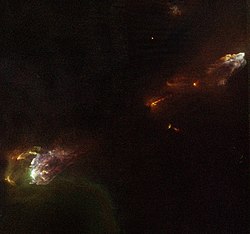HH 1/2
| Emission nebula | |
|---|---|
| Herbig–Haro object | |
 Hubble Space Telescope WFC3 image of HH 1/2 and the jet pointing to HH 1 (right) | |
| Observation data: J2000.0 epoch | |
| Right ascension | 05h 36m 22.8s[1] |
| Declination | −06° 46′ 03″[1] |
| Distance | 1500[2] ly |
| Constellation | Orion[2] |
| Designations | HH 1-2, HH 1/2, HH 1, HH 2 |
The Herbig-Haro objects HH 1/2 are the first such objects to be recognized as Herbig-Haro objects and were discovered by George Herbig and Guillermo Haro.[3][4][2][5] They are located at a distance of about 1343 light-years (412 parsec) in the constellation Orion near NGC 1999.[3] HH 1/2 are among the brightest Herbig-Haro objects in the sky and consist of a pair of oppositely oriented bow shocks, separated by 2.5 arcminutes (a projected separation of about 1.1 light year). The HH 1/2 pair were the first Herbig-Haro objects with detected proper motion[6] and HH 2 was the first Herbig-Haro object to be detected in x-rays.[7] Some of the structures in the Herbig-Haro Objects move with a speed of 400 km/s.[2]
The central region
The central region contains an opaque cloud core with an astrophysical jet[8] and a highly embedded multiple-star system that remains invisible below 3 Microns. These sources were first detected with the Very Large Array and are therefore named VLA 1 and 2.[9] The source HH 1-2 VLA 1[10] drives the HH 1/2 pair and the source VLA 2 drives the Herbig-Haro objects HH 144/145.[11] There might be even a third outflow in the central region of HH 1/2, indicating a third member.[12]
The jet towards HH 1 is visible in optical images, but the counterjet towards HH 2 was detected in the infrared with the Spitzer Space Telescope.[13]
Gallery
-
An older version of the region mapped by the WFPC2 of the Hubble Space Telescope. The image also shows the jet in the lower right part in more detail
-
The reflection nebula NGC 1999 (blue cloud in the center) and the Herbig-Haro Objects HH 1/2 below NGC 1999 as small pink clouds.
References
- ^ a b "HH 1-2". SIMBAD. Centre de données astronomiques de Strasbourg. Retrieved 2020-02-15.
- ^ a b c d Bally, John; Heathcote, Steve; Reipurth, Bo; Morse, Jon; Hartigan, Patrick; Schwartz, Richard (May 2002). "Hubble Space Telescope Observations of Proper Motions in Herbig-Haro Objects 1 and 2". The Astronomical Journal. 123 (5): 2627–2657. Bibcode:2002AJ....123.2627B. doi:10.1086/339837. ISSN 0004-6256. S2CID 118242041.
- ^ a b Herbig, George H. (May 1951). "The Spectra of Two Nebulous Objects Near NGC 1999". The Astrophysical Journal. 113: 697–699. Bibcode:1951ApJ...113..697H. doi:10.1086/145440. ISSN 0004-637X.
- ^ Haro, Guillermo (May 1952). "Herbig's Nebulous Objects Near NGC 1999". The Astrophysical Journal. 115: 572. Bibcode:1952ApJ...115..572H. doi:10.1086/145576. ISSN 0004-637X.
- ^ Raga, A. C.; Reipurth, Bo; Castellanos-Ramírez, A.; Chiang, Hsin-Fang; Bally, J. (October 2015). "High Angular Resolution Multi-line Study of HH 1 and 2". The Astronomical Journal. 150 (4): 105. Bibcode:2015AJ....150..105R. doi:10.1088/0004-6256/150/4/105. ISSN 0004-6256. S2CID 125612968.
- ^ Herbig, G. H.; Jones, B. F. (August 1981). "Large proper motions of the Herbig-Haro objects HH 1 and HH 2". The Astronomical Journal. 86: 1232–1244. Bibcode:1981AJ.....86.1232H. doi:10.1086/113003. ISSN 0004-6256.
- ^ Pravdo, Steven H.; Feigelson, Eric D.; Garmire, Gordon; Maeda, Yoshitomo; Tsuboi, Yohko; Bally, John (October 2001). "Discovery of X-rays from the protostellar outflow object HH2". Nature. 413 (6857): 708–711. Bibcode:2001Natur.413..708P. doi:10.1038/35099508. ISSN 0028-0836. PMID 11607024. S2CID 13878953.
- ^ Bohigas, J.; Torrelles, J. M.; Echevarria, J.; Canto, J.; Enriquez, R.; Firmani, C.; Gutierrez, L.; Ruiz, E.; Salas, L. (December 1985). "Optical images of the region around HH1 and HH2 taken with the MEPSICRON system". Revista Mexicana de Astronomía y Astrofísica. 11: 149–157. Bibcode:1985RMxAA..11..149B. ISSN 0185-1101.
- ^ Rodríguez, Luis F.; Delgado-Arellano, Víctor G.; Gómez, Yolanda; Reipurth, Bo; Torrelles, José M.; Noriega-Crespo, Alberto; Raga, Alejandro C.; Cantó, Jorge (February 2000). "New VLA Observations of the HH 1-2 Region: Evidence for Density Enhancements Moving along the Axis of the VLA 1 Radio Jet". The Astronomical Journal. 119 (2): 882–889. Bibcode:2000AJ....119..882R. doi:10.1086/301231. ISSN 0004-6256. S2CID 59520064.
- ^ "HH 1-2 VLA 1". SIMBAD. Centre de données astronomiques de Strasbourg. Retrieved 2020-02-15.
- ^ Reipurth, Bo; Heathcote, Steve; Roth, M.; Noriega-Crespo, A.; Raga, A. C. (May 1993). "A New Herbig-Haro Flow in the HH 1--2 Complex". The Astrophysical Journal. 408: L49. Bibcode:1993ApJ...408L..49R. doi:10.1086/186828. ISSN 0004-637X.
- ^ Hester, J. Jeff; Stapelfeldt, Karl R.; Scowen, Paul A. (July 1998). "Hubble Space Telescope Wide Field Planetary Camera 2 Observations of HH 1-2". The Astronomical Journal. 116 (1): 372–395. Bibcode:1998AJ....116..372H. doi:10.1086/300396. ISSN 0004-6256.
- ^ Noriega-Crespo, A.; Raga, A. C. (May 2012). "Spitzer Observations of the HH 1/2 System: The Discovery of the Counterjet". The Astrophysical Journal. 750 (2): 101. arXiv:1203.1032. Bibcode:2012ApJ...750..101N. doi:10.1088/0004-637X/750/2/101. ISSN 0004-637X. S2CID 1793062.



